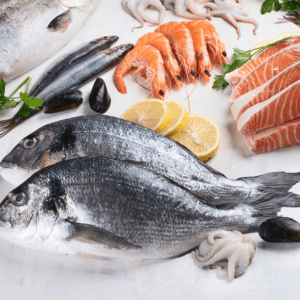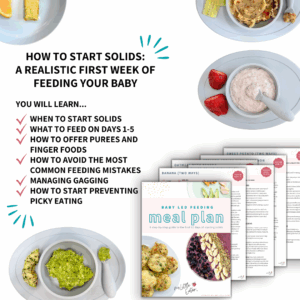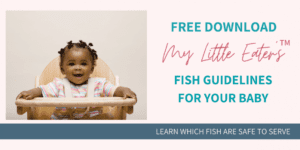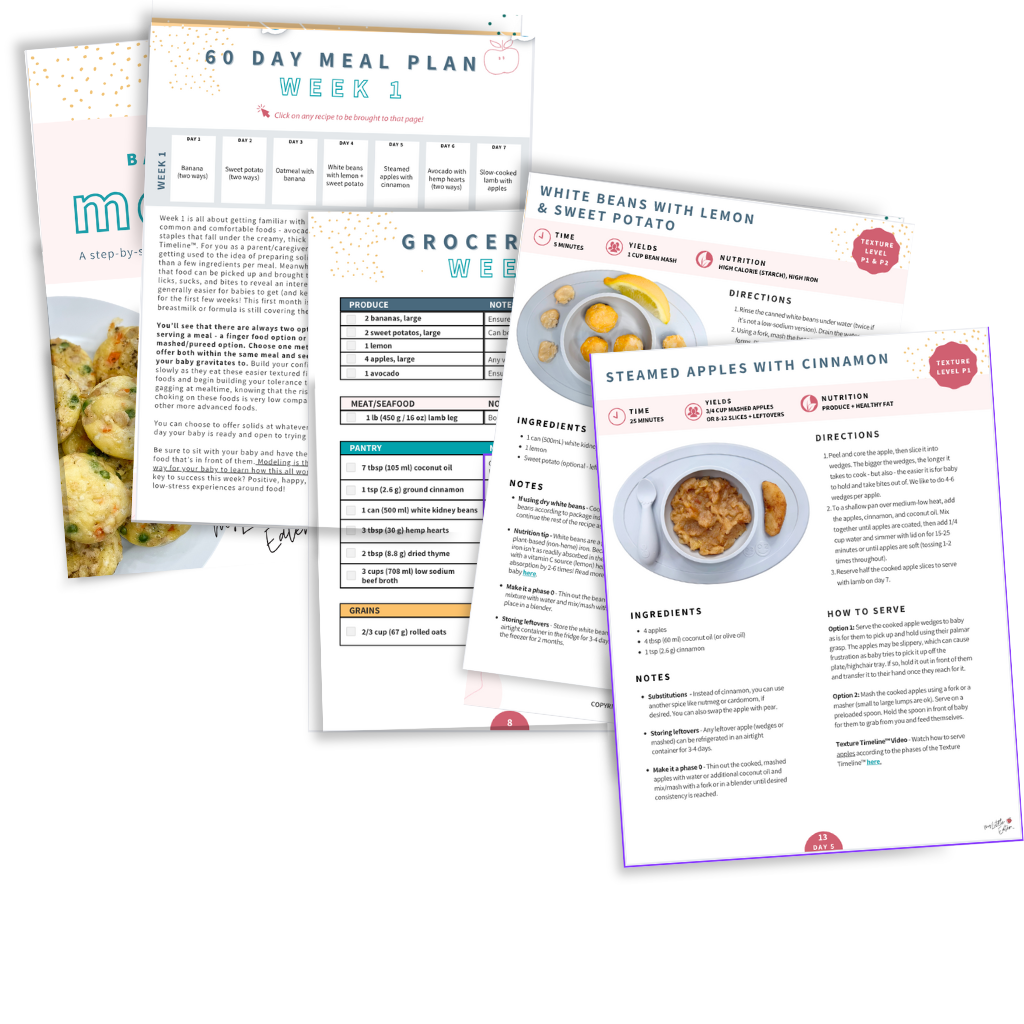
There have been so many things floating around lately on the best and worst fish to offer your baby. There is definitely a lot to know about this topic, and it’s important we’re educated on it. I’m seeing that a lot of the advice around fish for babies seems very black and white. Either this fish is good to offer and offer it frequently…or just completely avoid it. I don’t believe it needs to be as restrictive as that. There are SO many types of fish out there that are delicious and nutritious, and accessible to us to different extents, that limiting it to a few types of fish that we can offer our baby makes things stressful on us parents, and really doesn’t show us the whole picture of how varied a baby’s diet can be. I also have some major qualms with the official guidelines for fish for babies from major regulatory bodies (more info on that below). The lack of detail around the safe options for babies and the quantities they can consume them in makes me go crazy! So…I’ll dive into the research for you in this blog. I want to educate you on the nitty gritty details around what makes fish either “good” or “bad”, and how to offer it, and with what frequency to offer it, to your baby in ways that are safe…without overthinking it!

If you’re feeling stressed about starting solids and you’re not sure where to begin, join our FREE live workshop – How to start solids: A realistic first week of feeding your baby. This workshop is for parents ready to feel confident and prepared to start solids—without all the guesswork.
Learn exactly what to feed, when to feed it, and how to do it—step-by-step—with expert guidance from pediatric dietitian, Edwena Kennedy. Plus, get a free 5 day meal plan just for attending!
PS>> I have a free cheat sheet to download at the end of this blog post summarizing the best fish for your baby and frequency to offer each one – but you can download it here if you want to jump ahead!
Now, it’s not easy navigating the world of fish when there are so many subtypes of fish out there – it can get really confusing! We typically see many details around the name of a fish – for example, salmon. There’s farmed and wild salmon, Pacific and Atlantic salmon, pink and sockeye salmon. And a combination of each of those together. And some of them are recommended for babies, while others aren’t!
I want to first clarify that when I talk about fish, what I really mean is all seafood. This includes shellfish (for example crustaceans such as shrimp, crab, and lobster) and mollusks (such as clams, mussels, oysters, scallops, and octopus).
This is a lot of info, so if you’d prefer to listen as you go about your day, check out the podcast episode below because I explain it all there too!
The benefits of fish for your baby
- High in protein – important for growth of all organs, bones, muscles, immune system, hormones, cells…you name it.
- High in iron – which you want to include in every meal for babies whenever possible – it’s a very important nutrient for them. Fish is specifically a source of heme iron, which is a more readily absorbed form of iron in the body, and so it can be particularly helpful for babies for reaching their requirement of 11 mg of absorbed iron/day.
- High in B12 – this is important for healthy red blood cell production and brain development.
- Certain fish are high in DHA – we’re going to talk about that in more detail later in this post, but know that DHA is so important for brain growth and eye development. This is particularly true for babies because their brain and neural system is rapidly growing and developing until the point of 3 years of age. Fish is the only food out there with concentrations of DHA in enough quantity to give us what we need, so it actually plays a very important and critical role in the health of babies.
- High in Vitamin D – this is found in fatty fish especially, and these are the same fish that are also high in DHA.
- High in Calcium – especially when the bones are consumed, which even for babies is very possible. The bones in canned salmon, for example, are very soft and can be slightly smashed with your finger, or mashed with a fork, and offered for big nutritional benefit.
- Adds significant variety – in taste, smell, and texture for babies to learn about. We want to expose babies to as many flavours and textures as possible, and early introduction of fish broadens babies’ willingness to accept it, and other seafood, down the road.
- Convenient to cook – it’s fast and easy to prepare, most fish cooks in as little as 15-20 min. and just needs to be baked with little prep, or even any need for lots of seasonings!
- Allergenic food – this is neither an inherently good or bad thing, but it’s just important to note that it should be introduced early and often so that your baby is exposed to it, which reduces the chances of developing an allergy to it. FYI fish allergy is different from shellfish allergy, so both fish and shellfish need to be introduced separately to clear out any risk of developing an allergic reaction.
However, not all fish are created equal
- Certain fish are high in mercury. Mercury (or more specifically methylmercury) is a heavy metal that can build up in fish meat and fish organs. It’s present in larger quantities in larger fish (since they eat other fish, which allows them to accumulate the mercury of the smaller fish they eat in their tissues). It’s also present in higher levels in older fish since they accumulate more mercury in their tissues over time, because they’ve been around for longer. However, mercury is found in all types of fish, to some extent, since it’s released into the air, then settles into water. Children are especially vulnerable and may be exposed directly by eating contaminated fish. Higher mercury fish consumed when pregnant may lead to neurodevelopmental problems in the developing fetus since their brain is very sensitive. Neurological symptoms include intellectual disabilities, seizures, vision and hearing loss, delayed development, language disorders and memory loss.
- Other contaminants like arsenic can also be an issue, but this highly depends on what lake, river, or ocean the fish is from – and there will usually be environmental reports and advisories around certain size fish from certain areas.
- Some fish are higher in salt than others. Guidelines currently state that babies should have about 400 mg of sodium per day, but you may not need to worry as much about salt intake for babies as you might think. Listen to this podcast episode to hear why the fuss around salt for babies is actually not rooted in any solid evidence. Be aware of how much salt your baby is getting from processed foods, but naturally occurring salt in certain fish isn’t as much of a concern in the grand scheme of things, and especially not in comparison to the health benefits they may bring.
- Certain fish have high levels of antibiotics – particularly farmed fish…which leads me to the topic of farmed vs. wild caught fish.
Wild vs. Farmed
Let’s review the definition of each.
Wild fish is caught in natural environments such as oceans, rivers, and lakes. They live free to simply do what fish do and thrive. Farmed fish are raised by fish farms in a controlled environment. Their homes are man-made tanks, or pens, that are placed in large bodies of water, such as the ocean, or lakes and rivers, which are closely monitored in order to produce as many fish as possible, and keep them alive and healthy. The quality control differs from one fish farm to the next.
Because they’re being produced in large quantities, and live in more confined areas, farm raised fish can be more prone to disease and illness. This means they are often pumped with antibiotics and medications, which, unfortunately, are passed along to consumers too. Not to mention other contaminants that could be present, like pesticides and PCBs.
However, mercury levels on the other hand, may be higher in wild caught fish (although both types of fish can contain mercury because of our waters being so polluted).
Fish in their natural habitat tend to consume a more varied and higher quality diet than fish that are raised in a fish farm and fed a controlled diet. Because of this, wild fish, generally speaking, have less saturated fat than farm raised fish, but farmed fish may have a higher level of omega-3, because of the fortified feed they get. Some feed that’s given to farmed fish is better than others, though generally speaking, it’s often made with fishmeal, soy and/or corn, and wheat and other binding agents.
Farm-raised fish are more readily available and less expensive than wild-caught fish, and this then leads me to the issue of sustainability. Wild may be overfished or caught using methods that damage the natural habitat and put other fish in danger. Fish that are farm-raised can harm natural habitats and other breeds of fish through pollution of local waters, as they can introduce diseases and pests to wild populations, and also can escape the pens and breed with wild fish.
At the end of the day, it really all depends on the fishery you’re buying from. Ask questions to make sure who you’re purchasing from is practicing sustainable farm fishing methods, or raising fish in ways that are kind to the environment. I recommend heading to SeaChoice.org, which is run by five conservation groups, to see they’re recommendations for most sustainable fish types. They have a green, yellow, and red label system to help guide us to the best choices based on factors they’ve weighed out, such as: waste pollution, habitat, antibiotic use, fish feed, and escapes and parasite risk to native species.
Fresh vs. frozen vs. canned
Lastly, before we get into the guidelines and best types of fish for babies, I want to touch on the differences between fresh vs. frozen vs. canned fish.
The long and short of it is, all versions – whether canned, frozen, or fresh – are good to offer and have the same health benefits overall. The only exception is fresh/frozen tuna (we want to avoid this at all costs due to higher mercury levels) and only offer a specific type of canned tuna (canned light – which we’ll talk more about below).
Canned fish is very convenient, but always try to offer from a can that has a BPA free lining. As far as what the fish is canned in, try to avoid ones canned in sauces, it’s not the end of the world, but typically those will have added preservatives. Instead, look for fish that has been canned in water, or oil, both are totally fine. Finally, look for no-sodium added, or low-sodium, options, but if not possible, be sure to rinse the fish thoroughly in water before offering it to your baby.
Ok, back to fish and baby guidelines.
Recommended guidelines for fish for babies
The American Academy of Pediatrics recommends serving 1 ounce of low-mercury fish, once or twice per week to toddlers (age 2 and up). They follow FDA + EPA guidelines, which state that “best” low-mercury options are anything under 0.15 ppm of methylmercury and “good” options are anything under 0.46 ppm of methylmercury. However, there aren’t any recommendations from the AAP for how much babies should get, per say. So it’s not to say that the FDA + EPA recommendations mentioned above aren’t good…but the label of “Best” and “Good” choices for fish are for adults who can handle more mercury than babies can.
Health Canada on the other hand, does address this for babies. According to them, they say that there is no limit to the amount of most retail fish in Canada, with the exception of placing a limit on the amount of higher mercury fish. Retail fish (aka low-mercury fish) is approved if it’s been deemed to contain no more than 0.5 ppm (parts per million) total mercury (including all canned tuna) except fresh/frozen tuna, shark, swordfish, escolar, marlin, and orange roughy. All canned tuna, including albacore, is typically below the Canadian standard of 0.5 ppm total mercury.
However, because canned albacore (white) tuna is so popular, it may be chosen more often than other types of fish, and so for this reason, a separate advisory exists for this even though it falls under the “low” mercury category. So, in Canada, this advisory says that babies should get no more than about 40 g or 1.4 oz per week of canned albacore tuna, and should get less than 1.4oz or 40g/month of any very high mercury fish (like shark, orange roughy, etc.)
According to Health Canada, the same concerns don’t exist for canned “light” tuna because the type of fish used for this are younger and smaller and therefore lower in mercury (skipjack and tongol) than the larger tuna fish that are sold as fresh and frozen products, or canned albacore tuna.
Here’s the thing…Health Canada’s reasoning for this is that it’s “considered unlikely that an infant could consume enough fish to be exposed to an unacceptable amount of mercury”. However, thanks to Baby Led Feeding and the stressed importance of offering textured foods in as much variety and flavours as possible before 9 months of age, coupled with the fact that we now know to introduce highly allergenic foods (of which fish and shellfish are ones) to our baby as close to 6 months of age as possible, and to offer it often…babies definitely do have the capability of consuming significant amounts of fish…and therefore mercury. Many babies eat more than the average toddler, and with all the education we have as parents on how to build a baby’s eating skills so they’re getting a significant amount of calories from food, this means that we can’t count on the fact that babies are only getting a “touch” of fish in insignificant amounts.
In fact, we don’t have a lot of room for assumptions on this. In 2004, the Joint FAO/WHO Expert Committee on Food Additives (JECFA) established a tolerable intake of 1.6 µg/kg bodyweight per week for methylmercury for fetuses and extrapolated it to children under 17 years old. This means that a 9 month old baby that weighs 19 lbs would reach their weekly max amount from getting 13.78 micrograms of mercury, the amount found in:
- 48 oz. of salmon per week (safe to say that’s impossible)
- 1.9 oz. of halibut (that’s about 4 pinky length pieces of fish per week – this is very possible)
- 1.2 oz. of fresh tuna and 0.5 oz. of shark (aka a bite or two per week – don’t even attempt it)
So, you can see that based on these amounts, Health Canada has got it right in that there are some types of fish that you should literally never offer your baby (since one or two bites puts them at the limit), and there are other types of fish that are totally fine to offer in virtually unlimited amounts (like salmon). However, there are A LOT of “in-between” fish types that Health Canada doesn’t distinguish between, that could be potentially dangerous if your baby has a good appetite, or you offer it too frequently.
So for babies, we like to be extra safe. There are enough ultra low mercury fish out there that we don’t need to risk dangerous outcomes by offering moderately high mercury fish, especially frequently.
MLE’s guidelines for fish intake for your baby
Let’s start with portion sizes for babies. As mentioned earlier, regulatory bodies, like the AAP, indicate specific portions of 2 x 1 oz. of fish for toddlers. Health Canada also has specific portions for how much to offer for babies for those questionably high mercury fish.
Here’s why I don’t like that.
If your baby is hungry, then the baby led feeding philosophy I live and breathe by, says to offer your baby more food. We provide food for them that we’ve determined to be acceptable at mealtime, and we let them choose if and how much they want to eat. That can be a little bit (and may fall within the 1-2 oz. per week they recommend)…or that can be a lot (I’ve seen babies eat 3-4 oz. of fish in one sitting). By giving them a little bit, and then taking it away from them, even after they indicate they want more, we start to influence their eating and teach them that they can’t be trusted to choose what to eat.
But here’s the other thing…I don’t want to be worried about measuring out 1 oz. servings of fish, and then worrying about it when they smush it up in their little hands and spread it all over the high chair tray, or their mouth, and actually get only select amounts in their mouth. Did they eat the full oz.? Was that more like ½ oz.? ⅓ oz.? Did they swallow it all?
Nope. I don’t want to do that…and I can bet you don’t either.
So, if we’re to be giving fish to our baby without limit at each meal, my criteria is to choose fish that only has 0.06 ppm of methylmercury or less (we’ll call this the ultra low mercury category). This ensures that you can offer these types of fish twice per week and have them show up on your menu fairly frequently, and that your baby can eat a large amount of it without there being any concern.
Anything between 0.07 and 0.15 ppm is also fine, but offer it less frequently, more on a bi-weekly basis (we’ll call this the low mercury category). Again, allow your baby to eat to the point of fullness.
Anything between 0.016 and 0.25 ppm falls under the moderately high mercury category for babies, and should be consumed on a monthly basis.
If it falls between 0.25 and 0.45 ppm, it’s considered very high in mercury, and should be completely avoided for babies.
Now, my next qualm with the current guidelines. Both the AAP and Health Canada also fail to clarify that these fish types should ideally be fatty fish sources if we’re to ensure babies are getting enough DHA in. Since babies 7-12 months of age need 10 to 12 milligrams of DHA per kilogram of body weight, that means, we’ve got to incorporate this into our guidelines, so My Little Eater™ endorses the consumption of 2 x 1 oz. servings of ultra low mercury, DHA rich, fish per week.
So to summarize MLE’s recommended fish guidelines for babies, we suggest:
- Offer ultra low mercury fish weekly, aiming for at least 2 x 1 oz. servings of DHA rich options per week.
- Offer low mercury fish once every two weeks.
- Offer moderately high mercury fish once every month.
- Avoid high mercury fish for babies altogether.
MLE’s fish picks for babies and toddlers
Alright, so here’s a list of the best fish to offer babies and toddlers, in terms of them being high in DHA and falling into MLE’s ultra low mercury category. Those that are red are higher in DHA (with at least 0.4 g DHA/100 g), and should be focused on offering twice per week. Remember, the other ones are still wonderful high protein, high iron options.
Offer these fish as often as you like, aiming for at least 2 x 1 oz. servings per week:
- Salmon (Atlantic farmed, fresh, or canned, or Pacific wild)
- Sardines
- Arctic Char
- Atlantic mackerel
- American Shad
- Anchovies
- Oysters
- Pollock (Boston bluefish)
- Tilapia
- Crawfish
- Mullet
- Catfish
- Whiting
- Clam
- Crab
- Scallops
- Cod
- Sole
- Flounder
- Haddock
- Shrimp
- Squid
- Butterfish
- Mullet
- Branzino (farmed) (this is a type of sea bass)
Fish to offer no more than once every two weeks:
- Farmed freshwater rainbow trout
- Steelhead trout
- Black Sea Bass
- Striped Bass
- Herring (if buying jarred/preserved Herring, rinse well under water to remove excess salt before serving to baby)
- Pacific Chub mackerel
- White fish
- Canned light tuna*
- Smelt
- Skate
- Perch
- Pickerel
- Atlantic Croaker
- Lobster
- Hake
- Buffalo fish
- Carp
- Sheepshead
- Tilefish (not from Gulf of Mexico)
*A special note is required for canned light tuna due to all the controversy out there in internet land about it. It has some mercury, but technically it still falls within MLE’s low mercury criteria (0.13 ppm). This means that your child would have to eat 3.73 oz. of it per week before reaching max limits. If offered once every two weeks, your baby can eat as much as almost 8 oz. of it in one sitting. If they are somehow actually able to eat that much fish in one sitting, I would move it to the once per month category.
The problem coming up lately is that testing on individual cans of tuna shows that there are some cans that can contain higher mercury levels than what is stated by the FDA. There will always be some variance amongst one tuna over the other, when testing has been conducted.
If you are concerned even slightly about it, consider purchasing your tuna from Safe Catch. They test every single tuna they use in their canned products, and have mercury limits that are 10x stricter than the FDA’s (no more than 0.1 ppm for Safe Catch Elite products). The same goes for their sardines and salmon products as well.
One more thing to note…tuna is typically very high in DHA and when looked up online, on most lists it shows up as a high DHA containing food. However, remember…the type of tuna we want to serve baby is canned, light, which although has some DHA, it doesn’t contain high levels of it.
Fish to offer no more than once a month:
- Halibut
- Mahi Mahi
- Grouper
- Monkfish
- Rockfish
- Snapper
- Weakfish/sea trout
Fish to avoid completely (those in blue can be offered after two years of age on a once per month basis):
- King mackerel
- Marlin
- Orange roughy
- Shark
- Swordfish
- Tilefish (from Gulf of Mexico)
- Tuna, bigeye
- Bluefish
- Chilean sea bass/Patagonian toothfish
- Sablefish
- Spanish mackerel
- Tuna, albacore / white tuna, canned
- Tuna, albacore / white tuna, fresh/frozen
- Tuna, yellowfin
- White croaker/Pacific croaker
There is unfortunately not enough data (according to the FDA) to determine where mussels fit into these guidelines, so I would exercise caution and avoid them until 1 year of age.
That was a lot of information, and so much to remember when deciding which fish to serve your baby, so I put it all together in a download for you! Grab it here, print it off, and keep it in the kitchen so you can easily reference it when planning out your baby’s menu.
If you’re looking for more details on what and how to serve your baby solids, along with all of the nutritional guidelines you could ever need, be sure to enroll in my Baby Led Feeding online course. Until March 31st, 2021, the course includes a 30 day meal plan with over 60 recipes, tried and tested by yours truly, so you can rest assured that they are all safe for your baby, and take the guesswork out of cooking for a month!
References:
- https://www.ncbi.nlm.nih.gov/pmc/articles/PMC3096006/
- https://www.epa.gov/fish-tech/epa-fda-fish-advice-technical-information
- https://www.canada.ca/en/health-canada/services/food-nutrition/food-safety/chemical-contaminants/environmental-contaminants/mercury/mercury-fish-questions-answers.html
- https://www.who.int/nutrition/topics/FFA_summary_rec_conclusion.pdf
- https://www.who.int/phe/news/Mercury-flyer.pdf
- https://www.who.int/news-room/fact-sheets/detail/mercury-and-health
- http://www.whfoods.com/genpage.php?tname=george&dbid=103
- https://seafood.oregonstate.edu/sites/agscid7/files/snic/omega-3-content-in-fish.pdf
- https://www.fda.gov/food/consumers/advice-about-eating-fish
- https://www.fda.gov/food/metals-and-your-food/mercury-levels-commercial-fish-and-shellfish-1990-2012







15 Comments
My Baby boy just turned 2. Can I give him American Channel Cat fish and canned wild sardines in EV Olive oil.
Please reply
Hi Christy! Both sardines and catfish are included in our list of fish options that are generally lower in mercury, so yes these can be offered to your toddler, aiming for at least 2x 1oz servings per week. Sardines are also high in DHA which is great 🙂
My granddaughter is 11 mo
Can she be given no sodium tuna or salmon and how often per week?
Hi Renee – great question! Salmon is a great choice for babies as it is a fish high in healthy fats that are very important for babies growth and development, and is also ultra low in mercury. You can offer salmon (atlantic farmed, fresh, or canned, or pacific wild) as often as you’d like, aiming for at least 2 x 1oz servings per week.
We recommend to completely avoid giving babies fresh or frozen tuna due to high mercury levels. However, canned light tuna has lower levels and is on our list of fish to offer no more than once every two weeks. I hope this helps! 🙂
Thank you for this fantastic guide! It’s so reassuring to have clear information on safe fish options for little ones. I appreciate the detailed explanations and the emphasis on sustainability. Can’t wait to try some of these recipes with my baby!
So glad you found this helpful!
Thank you for this comprehensive guide! It’s so helpful to know which fish are safe for my little one. I appreciate the tips on introducing fish to their diet and the emphasis on sustainability. Can’t wait to try some of these recommendations!
We’re so glad to hear you found this blog helpful!
This guide is so helpful! I had no idea which fish were safe for my little one. Thank you for breaking it down so clearly!
Thank you for this comprehensive guide! It’s so helpful to have a clear understanding of which fish are safe for my little one. I appreciate the focus on both nutrition and safety. I’ll be trying some of these recommendations soon!
This looks so helpful, but I some of the items on the list seem to contradict other lists I’ve seen out there. Do you mind giving a little more information about why cod is in the unlimited category when it’s listed much further down the FDA’s list? Are some lists using the mean concentrations and others using the median?
This is a great question! If you go on the FDA list, the median mercury concentration for cod is 0.066, which puts it in low/ultra low levels of mercury! The mean value can be skewed by outliers, but the median can better show an average level!
Thank you for this thorough guide! It’s so reassuring to have a list of safe fish options for my baby. I especially appreciate the tips on how to introduce fish into their diet. Can’t wait to try some of these recipes!
Thanks for this informative guide! It’s reassuring to know which fish are safest for our little ones. I especially appreciate the tips on cooking methods to retain nutrients. Can’t wait to try some of these with my baby!
Hello, This is so helpful!!! I am not able to download the guide. Could you please check ? Thank you!